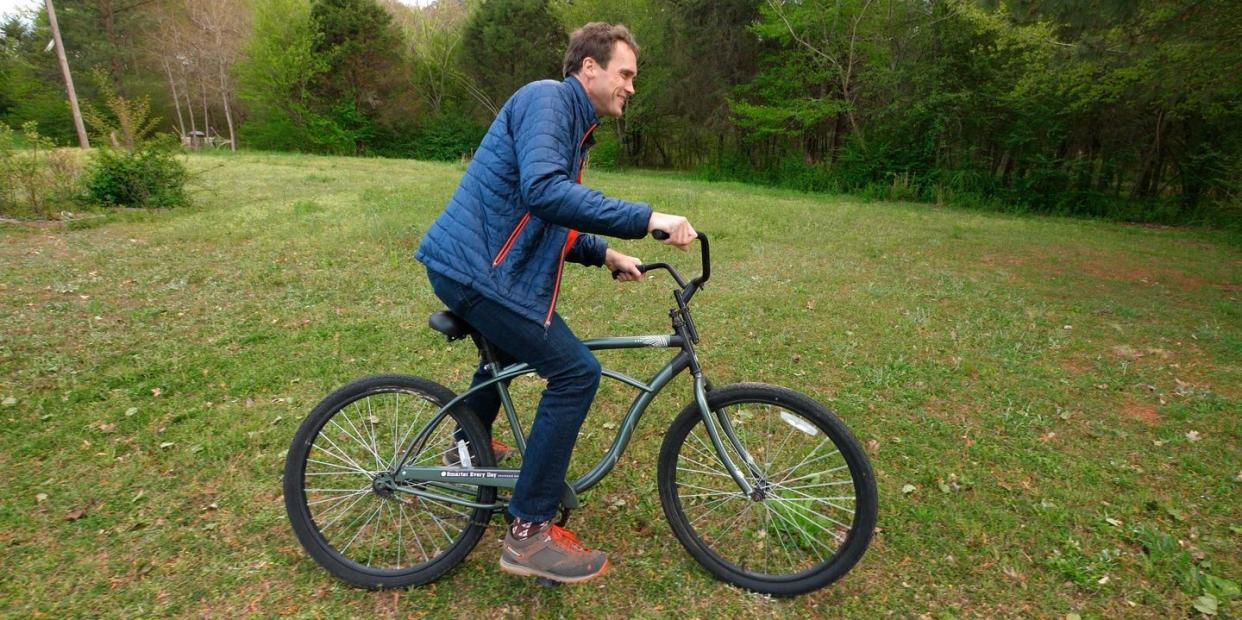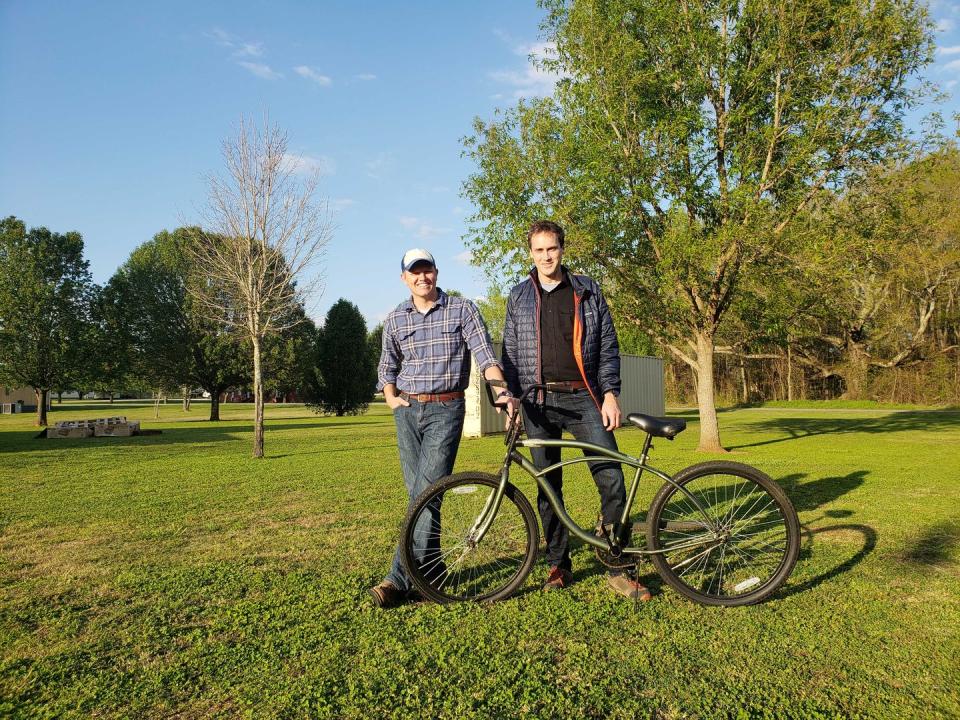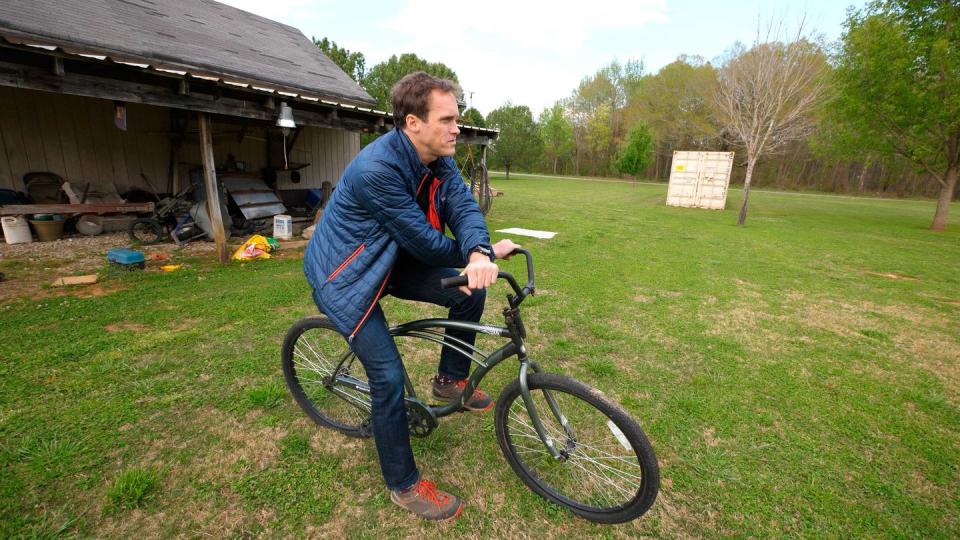Learning to Ride a Backward Bike Will Break Your Brain

For weeks ahead of my first ride, I had thought about the bike. Late at night, I would imagine ways to successfully ride it. I could cross my arms. I could ride no-handed. But the moment I actually straddled the bike and hoisted myself onto the seat, I felt a strange sensation. The bike had crept backward a few inches as I got on. It just felt off. I suddenly realized it was not going to be as easy as I imagined it to be.
I gave the left pedal a push, said “and away we go!” The handlebars wobbled for a moment, and before I had even completed one revolution on the pedals, I wrenched violently to the left. I tried it again, with the same result. I felt completely unmoored. Sitting on the bike was weirding me out. It felt wobbly, even though it was as stable as any bike.
How could a basic change to a simple machine I’d spent thousands of hours piloting so completely defeat me?
Have you ever noticed someone trip on a crack in the sidewalk, then turn around to accusingly stare at the offending impediment? The pedestrian thinks: Surely it can’t have been my fault. I’m an excellent walker—I take thousands of steps every day without even thinking about it!
Or that moment you approach an escalator that is out of order, but must still be used. You take a few steps, gingerly. You may even “feel” motion. That’s because your brain has trained itself, through hundreds or thousands of repetitions, of how walking on an escalator is supposed to be. It is ready for the escalator. Even though we know it’s broken, we can’t help thinking it’s not.
We shuffle through the world on autopilot, creatures of muscle memory and rote habit. “When we do something, we predict not only the outcome of the effect, but also the sensory consequences of that,” says Peter Beek, Ph.D., who studies movement science at the Vrije Universiteit in Amsterdam.
Usually, this works well, and we don’t think about it. It’s why you can’t tickle yourself: You already know what that’s going to feel like, so your cerebellum, neuroscientists suggest, has “canceled” the sensory input. But when your predictive model is violated—by that crack in the sidewalk or that non-moving escalator—your brain does a double-take.
One reason we rely on predictions, suggests Pablo Celnik, M.D., who directs a lab studying motor skills and the brain at The Johns Hopkins School of Medicine, is that our brains are too slow to keep up with our bodies. “Your brain receives feedback about what you’re doing,” he told me, “and that takes time—about 80 to 100 milliseconds.” What this means, he says, is “we live in the past. Whatever we see now is actually about 100 milliseconds ago for the motor domain.”
The better we become at doing something, argues Beek, the better we can make predictions about what’s going to happen. This is what it means to be skillful at something: Your movements become fast and fluid because, essentially, you already know what’s going to happen (and if something does go wrong, you’re experienced enough to know how to correct it).
Join Bicycling today for more great cycling news and tips!
As someone who’d been working on a book about the virtues of learning new skills at any age, I’d been talking to a variety of motor skills experts not only to help me understand how we learn to do things, but in the hopes of actually getting better at the things I was trying to learn (which ranged from surfing to singing—which, yes, is a motor skill).
More than one motor skills expert, when trying to explain this whole idea of skills as predictions, had mentioned to me the curious example of a “backward bicycle”—a bike that actually went right when the rider steered left, and vice versa. This, obviously, upends our whole internal model for how to ride a bike.
This caught my attention, for two reasons: One, riding a bike is the archetypal motor skill, widely accessible (“as easy as riding a bike,” we say) and, once learned, never forgotten. Second, I happen to pride myself on my bike skills. I’ve ridden downhill at over 50 mph wearing, basically, stretchy pajamas. I’ve sprinted in tightly packed bunches at high speeds in bike races. I once rode a few days with the man who set the record for cycling the most miles in a year.
A backward bike? How hard could it be?
And so I found myself, one spring afternoon, in a backyard of a ranch house in the small town of Lacey’s Spring, Alabama, about to get on what looked like an everyday beach cruiser.
Nearby stood Destin Sandlin, an engineer at the U.S. Army’s Redstone Arsenal (“we’re missile testers,” he said). He also hosts “Smarter Every Day,” popular YouTube channel in which he undertakes various stunts in the name of science. Sandlin, in appearance and levels of enthusiasm, seemed younger than he was. He wore a plaid shirt tucked into jeans.
Next to him was his friend Barney Dalton, a welder at an aerospace company, who Sandlin described as a “pretty straight arrow.” Dalton, wearing that Alabama bass fisherman uniform of a T-shirt, ball cap, and wraparound black sunglasses, was as taciturn as Sandlin was talkative. As I examined the bike, they both had a slightly bemused expression on their face, like they were remembering a familiar joke.
Years ago, Dalton had spotted a “money-making bike” at a county fair. Fairgoers would win money for successfully riding the bike; its name suggests how many did. He later built one up himself, mounting some old gears off of a Briggs & Stratton engine to the steerer tube of a bike. “If you have an even number of gears in any system it will change the rotation,” he explained.
He gave the bike to Sandlin. “To make fun of me,” Sandlin joked. “I got on it and it was like being struck by lightning,” he said. “My brain got in the way of my brain.” Later, after Sandlin had used the bike as a prop in various talks, Dalton started selling the reversed rides online.
What was particularly strange was that moving the bike just a few feet produced such a dramatic lurch. I felt like I was failing a sobriety test, stone sober. “It’s never gradual,” Sandlin said. “You just tip over.”
I was trying to puzzle out what was happening. “Have you ever flown a helicopter?” Sandlin asked me. “No? You should totally take a class.” Helicopter pilots, he explained, sometimes suffer from something called “pilot-induced oscillation.” Basically, they try to correct an error in one direction by overcompensating in the other direction. In a helicopter, where the simple act of hovering—what’s called “getting your hover button” — requires manipulating several coupled controllers, things can spin out of control very quickly.
“You’re used to riding a bike,” Sandlin said. “You naturally try to save yourself when you start to fall.” I was trying to “override” the fall I could see coming. But this was the wrong move. I needed to override the override.
I kept trying. I tried riding downhill, thinking if I didn’t have to pedal, the bike would be more stable. It was not. Riding no-handed was equally impossible, because in trying to balance the bike with my body I was doing it in the wrong direction. I moved to the road, thinking a smoother surface would help. It was worse: I weaved drunkenly across the center line. Simply walking the bike was incredibly difficult. “You’ll trip,” Dalton warned.
The one small measure of success I had—and I mean I rode a few feet—was when I stood and pedaled. “That’s how my son learned,” Dalton said. I wondered aloud why this was. “If you’re taller, your rotational inertia is higher,” Sandlin said. “The higher your fall, the more time to correct your fall.”
Sometimes it’s useful to have a rocket scientist on hand. “Do you want a helmet?” Dalton asked.
I felt, weirdly, a bit exhilaratingly, as if I were a kid again, learning to ride for the first time. It had actually taken Sandlin months of daily practice to get to where he could fluently ride the backwards bike. It was far harder than actually learning to ride a bike precisely because he already knew how to do that—and had for many years. “If you have learned something,” Peter Beek told me, “you cannot erase that history.”
His children, with less regular bike experience, learned the backwards bike more quickly. Sandlin was suffering what motor-skills people call interference: His old bike brain was getting in the way of his new bike brain.
Once he cracked the backward bike, a normal bike now seemed strange. On a trip to Washington, D.C. he panicked when he got on a bikeshare bike. He can now “switch” between the two modes—he even has a portable bike he rigged up to ride both ways—but the changeover is not always smooth.

Sitting on the backward bike, I could feel my head hurting. Cycling suddenly had a cognitive cost. Normally, we don’t think, we just ride.
What makes skills so, er—skillful—is in fact that we do not have much conscious access to them. “The aim of a skillful performance is achieved by the observance of a set of rules which are not known as such to the person following them,” wrote the eminent scientist Michael Polanyi in his book, Personal Knowledge.
The idea that how we execute a skill is distinct from what we know about a skill was first empirically shown in research involving Henry Molaison, the famous amnesiac. Given a variety of experimental tasks in the lab, Molaison (who had had parts of his brain removed in an effort to lessen the effects of epilepsy) showed day-to-day improvement. He got better, even though, as Suzanne Corkin describes in her book Permanent Present Tense, “he had no memory of having done the task before.”
In other words, Molaison might forget that he knew how to ride a bike, but he wouldn’t forget how to ride a bike. “Knowing how,” or what’s called “procedural memory,” lives in a different part of our brains than “knowing that,” or “declarative memory.” Molaison could even learn to ride a bike for the first time. But he was truly learning without awareness: Each day, no matter how well he had done the day before, he was telling himself he was a beginner.
What dawned on me, in that Alabama backyard, was not only that I didn’t know how to ride a backwards bike, I didn’t really know how I was able to ride a regular bike. Riding a bike, it turns out, for all its breezy universality, is a notoriously hard scientific nut to crack. Many an attempt to mathematically model a bicycle in motion sits dusty on university shelves. “Almost everyone can ride a bicycle,” observed the physicist David Jones, “but almost no one knows how they do it.”
The textbook explanation, Jones noted, is precisely what Sandlin and I were discussing: Riding a bike is a process of constantly correcting against potential falls by subtly steering in the direction one is falling. Like walking, riding is essentially a process of controlled falling. But then why, Jones wondered, could a riderless bicycle stay erect for as long as 20 seconds? There are, to this day, talented scientists still working on questions like this.
Jones himself had tried to create a number of “unrideable” bikes, with oddly angled forks and distracting extra wheels spinning in the opposite direction. The only problem was that he was able to ride them. With much work, and with the help of substantial computing power, he finally created one he could not ride. And who knows, with enough time, he might have cracked it.

If science can barely grasp bikes, how is the everyday rider supposed to? If you ask the average bike rider how to turn a bicycle, the answer will likely be: Turn the handlebars in the direction you want to go. But this is not technically true. As bike geeks from Wilbur Wright onward have noted, to go left you first have to steer to the right.
The physicist Joel Fajans has a nifty method for experiencing this “countersteering” (a phenomenon first described in the 19th century) for yourself. While riding downhill (so you don’t have to pedal), take your left hand off the handlebar. As you do that, put your right hand, palm open, on the right handlebar, and slightly apply pressure. The bike can only turn to the left. But you will go right.
Hardly anyone knows this because hardly anyone is aware of it. And we’re not aware of it because to actually know it, or at least to think of it while riding, would not actually help us ride. We ride by “the seat of our pants.”
Fajans’ example, helped me understand why it was so hard for me to ride a backwards bike. Now, to turn right, I actually needed to turn left, which actually meant first turning a little to the right, which meant, basically, I was screwing up.
My pattern was: wobble, wobble, wobble—LURCH! “That’s pilot oscillation error right there,” Sandlin said, as I nearly hit a birdhouse on a pole in Dalton’s yard. Clearly I wasn’t going to master the bike in one day, and the longer I tried, the worse I got. The best thing would be to walk away for a while, maybe even sleep on it—naps have been shown to boost skill learning. My brain needed time needed time to consolidate all these new inputs it was taking in.
My inability to ride said a lot about how we are able to ride. First, riding a backward bike is not just cycling, reversed; it’s more accurately thought of as an entirely different skill. Secondly, my habitual, “overlearned” bike riding skill is so entrenched it was getting in the way of learning the new bike.
To ride the backward bike, I would need a new algorithm. And, third, while I could think about how to ride the backward bike all I wanted, the best algorithm wouldn’t enable me to ride it. To do that I would simply have to ride. “There’s no secret,” Sandlin told me. “Just time in the saddle.”
You Might Also Like

